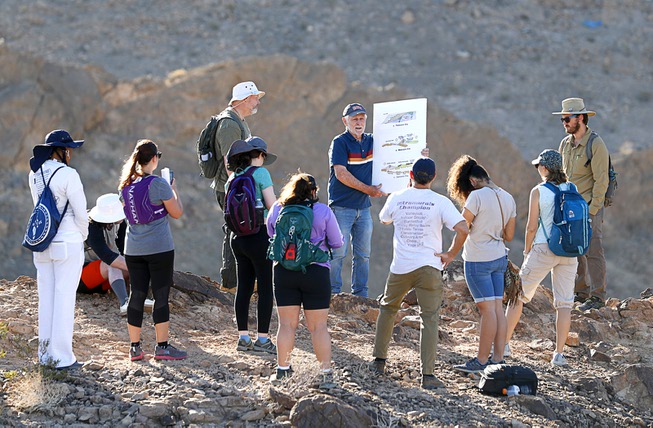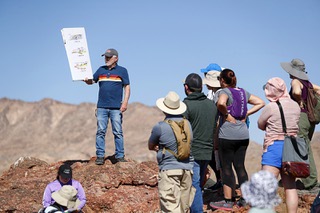
Retired UNLV geology professor Steve Rowland, center, talks with Clark County School District high school science teachers during a field trip at Frenchman Mountain Wednesday, June 21, 2023.
Monday, June 26, 2023 | 2 a.m.
More on education
High schoolers could read about the Great Unconformity in a geology textbook, or they could stand on a trail on Frenchman Mountain, notice that the rocks look different and wonder why.
In books, geology is in black and white.
On Frenchman Mountain, steps from Lake Mead Boulevard, it’s in sparkling pink granite, chocolate-hued schist and flaky sandstone that looks like a petrified croissant, all layered beside each other in a juxtaposition that educators might hope would feed right into “phenomenon-based learning.”
That’s an engagement strategy to hook students on science by starting with a striking visual and then encouraging students to investigate the “phenomenon” they’re seeing in an organic, self-led way.
To foster this phenomenon-based learning, about 20 high school science teachers from the Clark County School District paired with UNLV geologists last week for a four-day workshop as part of a grant from the National Science Foundation.
In the classroom and on field trips, the teachers — not all of them with earth science backgrounds — boosted their knowledge of the Las Vegas area’s abundant geological features and learned how to hook their students with locally relevant examples of scientific wonders.
They hiked in and around Red Rock Conservation Area to the west and Frenchman Mountain and Rainbow Gardens to the east, seeing and touching phenomena that their students could also dive into.
Kris Carroll, the science director for CCSD’s central Curriculum & Instruction Division and a former teacher at Green Valley and Clark high schools, said in the past, science instruction “often was experienced as, ‘here’s information.’ ” Maybe a lab backed up the information in the book. But that’s not how we now understand student learning, he said.
Calling phenomenon-based learning “hands-on” is an oversimplification, he added.
At Frenchman Mountain on Wednesday, the teachers were the students with Steve Rowland — a retired UNLV professor and advocate for getting the Frenchman and Sunrise Mountain areas national monument status — leading the way.
Frenchman Mountain is “a wonderful place to look at geology at whatever level you want to look at it,” Rowland said.
Literally, that can take only a few leisurely minutes of walking from a parking lot and crouching down to run one’s hands over a tilted layer cake of exposed rock that looks 1.2 billion years into the earth’s record — a portion of the Great Unconformity, a meeting of the earth’s layers that stretches across North America mostly buried but sees the light of day here.
About 1.7 billion years ago, granite and schist from deep within the earth’s crust pushed up to the surface, Rowland explains. As sea levels rose, sand and mud from the advancing ocean covered this exposed surface and sandstone formed, about 500,000 years ago. In geologic terms, the surface of the granite and schist is an “unconformity.” The 1.2 billion-year difference between that and the sandstone is an interval that represents more than one-quarter of the age of the planet.
A few minutes’ drive east of here is Rainbow Gardens, where geologists like Rowland can contemplate Southern Nevada’s tectonic history — how the earth’s crust has moved over the eons to make coarse granite and ruddy sandstone sit side-by-side.
Rowland encouraged the teachers to pick over the rocks and slip some in their pockets for their classrooms. Rainbow Gardens is on Bureau of Land Management land, where rockhounding is allowed.
Nate Williams, who teaches at Las Vegas High School, has a broad science background but hasn’t taught geology and now has more examples to hook his students with.
“Any practice I can get for that will be helpful,” he said, surrounded by the granite hunks and sandstone dust.
Kit Morse, who teaches at Legacy High School in North Las Vegas, said he doesn’t expect his students to become geologists — but what they learn, from what he just learned, will encourage them to be curious.
“They are going to learn how to solve problems,” he said.

